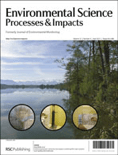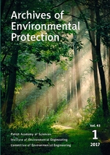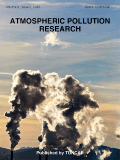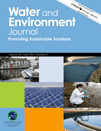
Environmental Science-Processes & Impacts
Scope & Guideline
Advancing knowledge for a sustainable tomorrow.
Introduction
Aims and Scopes
- Environmental Chemistry:
The journal extensively covers the chemical processes occurring in the environment, including the behavior, fate, and transport of pollutants and emerging contaminants. - Ecotoxicology:
Research on the effects of environmental contaminants on living organisms, particularly focusing on the impact of pollutants on terrestrial and aquatic ecosystems. - Air Quality and Atmospheric Science:
Studies related to atmospheric pollutants, their sources, transformations, and effects on human health and the environment. - Water Quality and Contamination:
Research focusing on water pollution, emerging contaminants, and the effectiveness of remediation technologies. - Sustainable Environmental Management:
The journal explores sustainable practices and technologies for managing environmental risks and promoting ecological health. - Microplastics and Nanoplastics:
A significant focus on the sources, fate, and ecological impacts of microplastics and nanoplastics in various environmental matrices. - Risk Assessment and Management:
Research aimed at assessing environmental risks posed by chemicals and pollutants, including human health implications and regulatory frameworks. - Climate Change Impacts:
Investigating the effects of climate change on environmental processes, pollutant dynamics, and ecological responses.
Trending and Emerging
- Emerging Contaminants:
There is a growing emphasis on studying emerging pollutants, particularly PFAS, microplastics, and pharmaceuticals, reflecting increased regulatory scrutiny and public concern. - Data Science and Modeling:
The integration of data science techniques, including machine learning and predictive modeling, is trending, indicating a shift towards more sophisticated analytical methods in environmental research. - Indoor Air Quality:
Research on indoor air pollution sources, health impacts, and mitigation strategies is gaining traction, highlighting the importance of indoor environments in public health. - Climate Resilience and Adaptation:
Studies focusing on climate change impacts and adaptive management strategies are increasingly prevalent, underlining the urgency of addressing climate-related challenges in environmental science. - Bioremediation and Green Technologies:
The journal is seeing a rise in publications related to innovative bioremediation techniques and environmentally friendly technologies for pollution management. - Microbial Interactions and Soil Health:
Research on the role of microorganisms in soil health and their interactions with pollutants is expanding, reflecting a growing recognition of biological processes in environmental remediation.
Declining or Waning
- Traditional Pollutants:
Research on legacy pollutants such as heavy metals has decreased as newer contaminants gain focus. This shift may reflect a growing awareness of emerging pollutants over traditional ones. - Agricultural Chemicals:
There appears to be a waning interest in studies solely focused on traditional agricultural pesticides, as newer studies incorporate a broader range of contaminants and their interactions. - Sociological Aspects of Environmental Science:
Papers exploring the sociological impacts of environmental issues have become less common, potentially indicating a shift toward more technical and chemical-focused research. - Historical Pollution Studies:
The journal has seen fewer publications on historical pollution and legacy studies, which may be attributed to a focus on current and emerging environmental challenges.
Similar Journals

ATMOSFERA
Your Gateway to Atmospheric Science ExcellenceATMOSFERA is a prestigious journal published by CENTRO CIENCIAS ATMOSFERA UNAM, dedicated to advancing the field of Atmospheric Science. With an ISSN of 0187-6236 and an E-ISSN of 2395-8812, this bilingual journal has been a vital resource for researchers since its inception in 1988. Located in Mexico City, the journal serves as a platform for high-quality original research, reviews, and case studies that explore various atmospheric phenomena, climate issues, and environmental challenges. Although currently categorized in the Q4 quartile of Atmospheric Science, ATMOSFERA aims to contribute to the growing body of knowledge in the field and improve its ranking over the next few years, emphasizing rigorous scientific inquiry and fostering collaboration among scholars. Its accessibility and commitment to open communication make it an essential reference for professionals and students striving to understand and address complex atmospheric dynamics.

Archives of Environmental Protection
Exploring Solutions for Environmental ChallengesArchives of Environmental Protection, published by the Polish Academy of Sciences, is a pivotal journal in the field of Environmental Science. With an ISSN of 2083-4772 and E-ISSN of 2083-4810, this journal serves as a critical platform for disseminating innovative research and comprehensive reviews that address the complexities surrounding environmental issues. As of 2023, it holds a respectable Q3 ranking in Environmental Science, reflecting its relevance and contribution to the academic community, indicated by a Scopus rank of 124 out of 233 in the General Environmental Science category. Although it operates without Open Access, the journal's consistent publication from 2007 to 2024 emphasizes its commitment to advancing knowledge in diverse areas of environmental protection. Researchers, professionals, and students are encouraged to engage deeply with the wealth of insights offered through the rigorous peer-reviewed articles presented in this journal, which strive to foster sustainable practices and environmental stewardship.

International Journal of Environmental Science and Technology
Transforming environmental challenges into actionable knowledge.International Journal of Environmental Science and Technology, published by SPRINGER, stands as a premier platform for the dissemination of cutting-edge research in the fields of environmental science, technology, and engineering. With an impressive scope spanning from 2005 to 2024, this journal serves as a vital resource for academic and professional communities engaged in tackling pressing environmental challenges. It boasts a strong reputation, evidenced by its Q1 ranking in Agricultural and Biological Sciences and solid placements in Environmental Chemistry and Engineering. Researchers searching for high-impact studies will find the journal's contributions significant, as reflected in its rankings within Scopus: 34th percentile in Agricultural and Biological Sciences and notable standings in Environmental Engineering and Chemistry. Although the journal is not currently an Open Access resource, it maintains a commitment to academic rigor and innovation, making it indispensable for those devoted to advancing knowledge in environmental sustainability and technology.

Reviews of Environmental Contamination and Toxicology
Illuminating the path to a healthier, safer planet.Reviews of Environmental Contamination and Toxicology is a leading journal published by SPRINGER, dedicated to advancing the understanding of environmental science, toxicology, and public health. Since its inception in 1987, this esteemed journal has established itself as an invaluable resource for researchers and practitioners alike, showcasing a wealth of peer-reviewed articles that delve into the complexities of environmental contaminants and their effects on human health and ecosystems. With an impressive impact factor and consistently ranking in the Q1 category across multiple fields including Health, Toxicology and Mutagenesis, as well as Public Health, this journal commands attention, boasting Scopus rankings that place it among the top-tier publications globally. Researchers will find that the journal provides not only in-depth reviews but also practical implications for policy and practice regarding environmental issues. Located in the heart of New York, Reviews of Environmental Contamination and Toxicology is poised to remain at the forefront of this critical field through 2024 and beyond, making it an essential addition to the library of any environmental health scholar or practitioner.

Carpathian Journal of Earth and Environmental Sciences
Advancing Earth Sciences for a Sustainable FutureCarpathian Journal of Earth and Environmental Sciences is a distinguished academic journal dedicated to advancing the interdisciplinary field of Earth and environmental sciences. Published by the Carpathian Association for Environment and Earth Sciences, this journal plays a pivotal role in disseminating high-quality research focused on the dynamic interactions between geological processes and environmental changes. With an ISSN of 1842-4090 and an E-ISSN of 1844-489X, the journal is indexed in Scopus and holds an esteemed Q3 quartile ranking in both Earth and Planetary Sciences and Environmental Science categories as of 2023. Since its inception in 2008, the Carpathian Journal has provided an open access platform for researchers, professionals, and students to share insights, foster collaboration, and engage in critical discussions on pressing environmental issues. By continuously contributing to the body of knowledge in this field, the journal not only enhances academic discourse but also promotes sustainable environmental practices across Romania and beyond.

Asian Journal of Atmospheric Environment
Exploring Innovative Solutions for Environmental ChallengesAsian Journal of Atmospheric Environment, published by SPRINGERNATURE, is a renowned open-access journal established in 2007, dedicated to advancing research in the fields of Atmospheric Science and Environmental Science. With an ISSN of 1976-6912 and E-ISSN of 2287-1160, the journal aims to offer a platform for the dissemination of cutting-edge research findings, reviews, and innovative methodologies addressing critical environmental issues faced in Asian and global contexts. As of 2023, it holds a respectable Q3 ranking in both Atmospheric Science and Environmental Science categories, positioning itself within the competitive landscape of scholarly publications. The journal is indexed in Scopus and emphasizes its commitment to enhancing accessibility and widespread dissemination of knowledge, making significant contributions to environmental sustainability and atmospheric research. Researchers, professionals, and students are encouraged to engage with the journal as it continues to evolve through its converged years, providing a vital resource for exploring and addressing the challenges that shape our atmospheric environment.

Atmospheric Pollution Research
Exploring solutions to breathe easy.Atmospheric Pollution Research is a pivotal journal within the realms of Atmospheric Science and Environmental Science, published by the Turkish National Committee on Air Pollution Research and Control (TUNCAP). With an impressive impact, it holds a Q2 ranking in Atmospheric Science and Waste Management and Disposal, and a Q1 ranking in Pollution as of 2023, underscoring its significance and influence in the field. The journal's ISSN 1309-1042 facilitates the dissemination of cutting-edge research addressing contemporary issues in air quality and pollution management. Spanning a convergence of years from 2010 to 2024, it publishes original articles, reviews, and case studies that are essential for advancing knowledge in air pollution and its environmental impacts. Researchers, professionals, and students worldwide will find this journal to be an invaluable resource for staying updated on the latest findings and innovations aimed at mitigating the effects of atmospheric pollution.

WATER AND ENVIRONMENT JOURNAL
Empowering voices in water and environmental science.WATER AND ENVIRONMENT JOURNAL is a prominent interdisciplinary journal dedicated to the latest research and advancements in the fields of water resources, environmental engineering, and pollution management. Published by WILEY, the journal has established itself as an essential resource for academics, practitioners, and policymakers since its inception in 1987. With an impressive impact factor reflecting its robust influence, it ranks in the Q2 and Q3 quartiles across multiple categories, including Water Science and Technology, Environmental Engineering, and Management, Monitoring, Policy and Law. The journal welcomes high-quality research articles, reviews, and case studies that address the critical challenges facing water and environmental sciences. As an open access publication, it provides a platform for widespread accessibility and engagement, ensuring that the knowledge generated is disseminated to a diverse audience. With a commitment to advancing understanding and solutions in water-related issues, WATER AND ENVIRONMENT JOURNAL plays a crucial role in shaping the future of environmental research and technology.

Environmental Sciences Europe
Bridging science and policy for a sustainable planet.Environmental Sciences Europe is a leading peer-reviewed journal published by SPRINGER, dedicated to advancing research in the field of environmental science, with a specific focus on pollution and its mitigation. Since its transition to Open Access in 2011, the journal has been committed to disseminating high-quality research without barriers, thereby ensuring that critical knowledge is freely accessible to researchers, practitioners, and policymakers around the globe. Based in Germany and with a commendable Q1 ranking in Pollution for 2023, the journal stands out in the Scopus rankings, occupying the 23rd position out of 167 in its category, reflecting its significant impact in shaping environmental discourse. With a convergence of global research efforts projected until 2024, Environmental Sciences Europe aims to provide a vital platform for scholarly communication and collaboration, ultimately contributing to sustainable solutions for pressing environmental challenges.

Environmental Science & Technology Letters
Exploring critical insights for a cleaner planet.Environmental Science & Technology Letters, published by the American Chemical Society, stands as a premier journal in the realm of environmental science and technology, focusing on pivotal studies that address pressing environmental challenges. With an impressive Q1 ranking in multiple categories including Ecology, Environmental Chemistry, and Pollution, this journal maintains a position of excellence within its field, achieving Scopus ranks that place it in the top percentile of Environmental Science disciplines. Although not open access, Environmental Science & Technology Letters offers vital insights and cutting-edge research that contribute significantly to the understanding and management of environmental issues. The journal’s objectives include disseminating ground-breaking findings and promoting discussions that lead to sustainable solutions. With convergence from 2013 to 2024, it continues to serve as an essential resource for researchers, professionals, and students committed to advancing knowledge and innovation in environmental science.